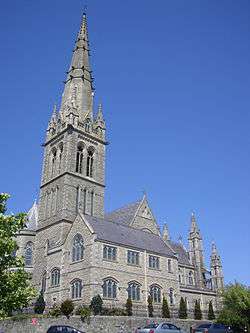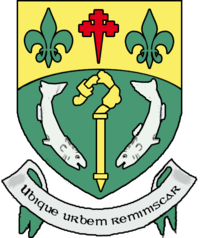Cathedral of St. Eunan and St. Columba

St. Eunan's Cathedral or the Cathedral of St. Eunan and St Columba as it is also known, is a Roman Catholic cathedral located in the parish of Conwal and Leck in Letterkenny, County Donegal, Ireland. It was built between the years of 1890 and 1900 and is the only Catholic cathedral in the county; however, an older Church of Ireland cathedral of the same name is located in the town of Raphoe.
The Cathedral was commissioned by late Cardinal O'Donnell, then Bishop of Raphoe, who in 1888 aged 32 became the youngest bishop in the world at that time.[1] The Cathedral, located on Castle Street opposite Conwal Parish Church in the town celebrated its centenary in 2001. The parish priests are Father Eamonn Kelly (Administrator), Father Eamonn McLaughlin and Father Philip Kemmy (curates).[2][3][4][5][6][7]
Description

The Cathedral opened on June 16, 1901 and is built in Victorian neo-Gothic style on a site overlooking the town. It was designed by William Hague, the well known Dublin architect and protégé of Pugin, and following Hague's death by his partner T. F. McNamara.[8] . Saint Eunan's Cathedral has a spire with a height of 240 feet. White sandstone from Mountcharles was used in the construction. It was shipped along the coast and up the Swilly. Townspeople carried bucketloads of the sandstone to the construction site piece by piece. The cathedral is furnished in oak, with a marble pulpit by Pearse Brothers of Dublin. The pulpit depicts statues of the Four Masters and the Four Evangelists.
The ceilings are the work of Amici of Rome, while the stained glass windows that illuminate the Sanctuary and the Lady Chapel are by the Mayer firm of Munich. They depict thirteen scenes from our Lords life. Celtic motifs and stained glass have been designed by Harry Clarke and Michael Healy. The Great Arch illustrates the lives of St. Eunan (better known as St Adhamhnáin) and St. Columba. The sanctuary lamp is made of solid silver and weighs over 1500 ounces. Some sculptures were created by William Pearse who took part in the Easter Rising.[9]
There are 12 bells in the Cathedral bell chamber. They carry the names of the saints of Tir Conail - Dallan, Conal and Fiacre, Adomnán, Baithen and Barron, Nelis and Mura, Fionán and Davog, Cartha and Caitríona, Taobhóg, Cróna and Ríanach, Ernan and Asica and Columba. The 12th bell weighs over 2 tons 5 cwts. After the Cathedral was opened the organist played "O'Donnell Abu", "St Patrick's Day", "The Last Rose of Summer", "The Wearing of the Green" and "The Bells of Shandon".[10]
The Cathedral was renovated and remodelled in 1985. Care was taken to preserve the style and materials of the original altar in the new altar table and chair. The original altar-piece, an Irish carving of Leonardo's Last Supper, is still present in the Cathedral and has been incorporated into the new altar.
The sandstone exterior of the cathedral was cleaned in July 2001. The stone was then repaired and pointed with a special mortar of lime and sand. Krystol Hydrostop was finally applied to the exterior.[11]
Adoration Chapel
The Blessed Sacrament Chapel of Adoration or The Adoration Chapel, as it is more commonly known as, is situated on the grounds of the Loreto Convent. It was officially opened on December 4, 1988 by the Bishop of Raphoe, Séamus Hegarty. This single-room chapel is a reconstructed building based on the site of an old school set up by the Loreto Sisters. It is not definitively known when the original building was constructed - however during reconstruction work in 1988, a slate bearing a mason's mark from the year 1850 was discovered. The chapel's granite altar was designed by Barry Feely from County Roscommon, and is located in front of a stained glass window which displays the "Virgin of the Sign" icon.[12]
Gallery
 Central aisle within the Cathedral
Central aisle within the Cathedral Cathedral pulpit
Cathedral pulpit Stained glass window within the Cathedral
Stained glass window within the Cathedral St. Eunan's Cathedral Grounds
St. Eunan's Cathedral Grounds Flying Buttress
Flying Buttress Carving on cathedral wall
Carving on cathedral wall
References
- ↑ Letterkenny, Co. Donegal, Ireland
- ↑ http://raphoediocese.ie/news-events
- ↑ http://raphoediocese.ie/component/diocesandatabase/?task=parish&cid=1
- ↑ http://www.donegalnow.com/article/4346
- ↑ http://raphoediocese.ie/news-events
- ↑ http://www.raphoediocese.ie/news-events/1-news/288-diocesan-appointments-2015
- ↑ http://www.raphoediocese.ie/component/diocesandatabase/?task=parish&cid=1
- ↑ Gerry Convery. “Poetry in Stone: Sacred Heart Church.” (Omagh: Drumragh RC Parish, 1999), p.8.
- ↑ Sculptures by William Pearse
- ↑ The Cathedral Bell Chamer. Published in the 1990 edition of The Letterkenny and District Christmas Annual, p.117
- ↑ St. Eunan's Cathedral - Solution
- ↑ The Adoration Chapel. Published in the 1990 edition of The Letterkenny and District Christmas Annual, p.100
External links
| Wikimedia Commons has media related to St. Eunan's Cathedral. |
Coordinates: 54°57′01″N 7°44′24″W / 54.95028°N 7.74000°W

